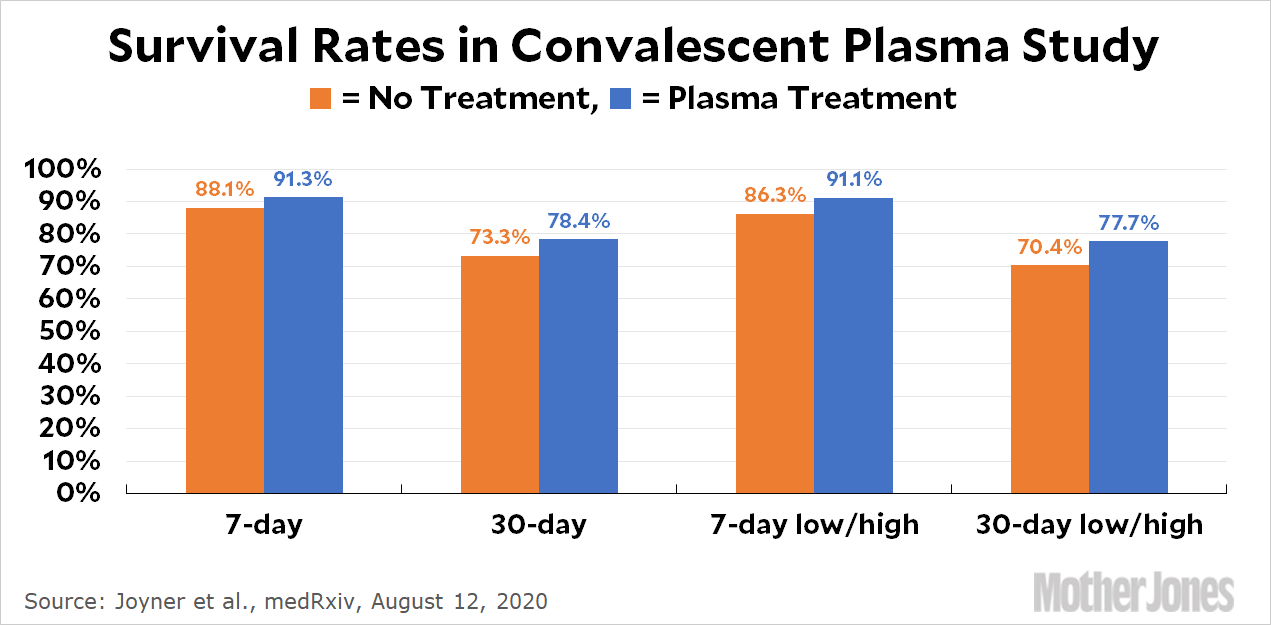With the Republican convention imminent, President Trump wants some good news. So he bullied the FDA into issuing an emergency approval for a COVID-19 treatment:
Calling it “a truly historic announcement,” U.S. President Donald Trump on Sunday hailed a federal government emergency authorization for use of convalescent blood plasma that he declared would “save countless lives” of coronavirus patients.
Trump and his health secretary, Alex Azar, at a briefing for reporters, noted a 35% decrease in mortality among those younger than 80 who were not on a respirator, a month after receiving the treatment early in the course of their disease. “We dream in drug development of something like a 35% mortality reduction,” Azar, the secretary of Health and Human Services, said alongside the president.
A “senior administration official” expanded on this:
“If you’re one of the 35 people out of a hundred who survive severe COVID symptoms because of convalescent plasma, this is certainly a breakthrough,” the official said.
Ahem. The treatment involves infusing patients with blood plasma from people who have recovered from COVID-19. This is very much a legitimate line of research, but it most certainly doesn’t save 35 lives out of a hundred or anything close to it. I know you count on me for chart-based versions of data like this, so here you go:

Among a subset of seriously ill patients, researchers produced several preliminary results:
- 7-day mortality. Survival rates were about 3 percentage points better with the plasma treatment if transfusion was done quickly after diagnosis.
- 30-day mortality. Survival rates were about 5 percentage points better with the plasma treatment if transfusion was done quickly after diagnosis.
- 7-day mortality with high IgG plasma vs. low IgG plasma. Survival rates were about 5 points better with high IgG plasma.
- 30-day mortality with high IgG plasma vs. low IgG plasma. Survival rates were about 7 points better with high IgG plasma.
Needless to say, none of these are anywhere close to what most people think of when they hear about a 35 percent difference. So where did that come from? Well, if you cherry pick one of the results—7-day high vs. low—and calculate the death rate instead of the survival rate, you get 8.9 divided by 13.7. This equals 0.65, which means the high-plasma group died at a rate 35 percent lower than the low plasma group on a relative basis. This is a number that might be of importance to a researcher or a statistician, but not to anyone else. For the lay public, the basic result is that plasma treatment might improve your survival rate by four or five percentage points.
In other words, the plasma treatment is promising but unlikely to make a huge difference. It’s certainly light years away from “historic” and in no way does it save 35 lives out of a hundred. Four or five is more like it. Nonetheless, Trump implied tremendous results; Azar confirmed it; FDA commissioner Stephen Hahn stayed silent; and a senior administration official then retailed an even more ridiculous version of the whole thing.
None of this was an accident. It was carefully designed to mislead the lay public into thinking that Trump had decisively ripped a miracle treatment out of the hands of the stupid doctors and made it available to everyone. He didn’t. Tens of thousands of people have already received plasma treatment and that will continue with little change. Eventually more careful studies will be done and we’ll have a better idea of just how well this treatment really works. In the meantime, as usual, never listen to anything that Donald Trump says about it.













